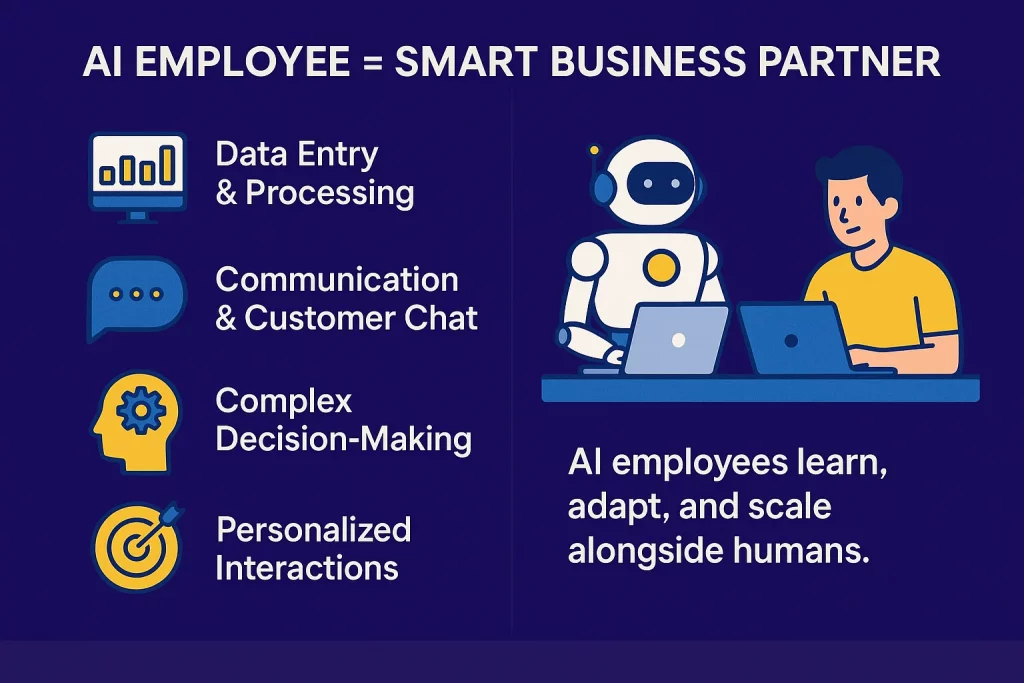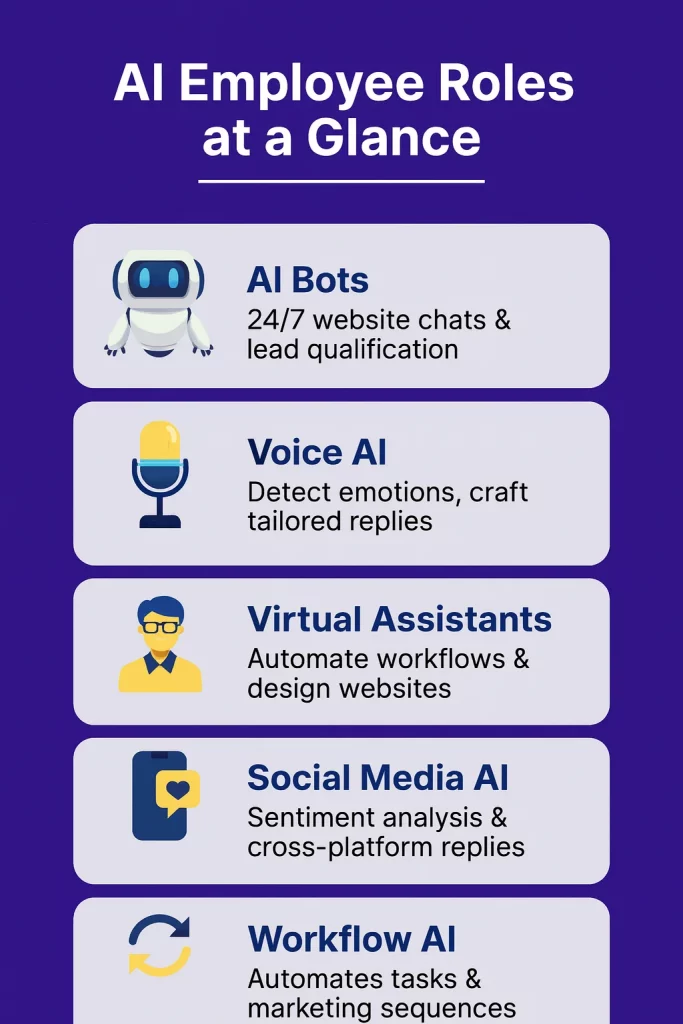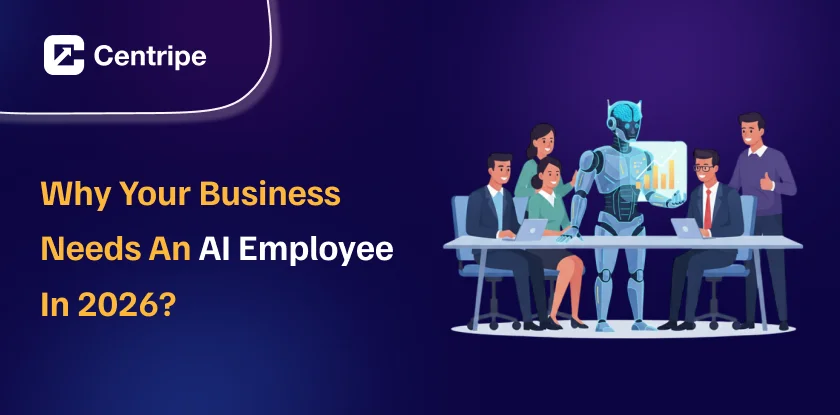ONLY those who are adopting AI will be ahead in business. At first, I used to worry about the accuracy with which AI can work.
Then, I deployed it in the system and now, just like me, many other CEO’s can say that it’s very necessary to have AI.
An IBM study found that 35% of organisations reported using AI in their business. This is a 4% increase from the previous year.
AI reduces the guesswork, lets employees focus on what really matters. With its insights, businesses can give an amazing experience to customers. They don’t have to wait in line for calls or wait hours for replies.
What is an AI Employee?

A set of smart tools that handles routine tasks like data entry, communication, complex decision making, and personalizing the interactions.
These AI employees learn and adapt constantly, unlike static software. With their thinking abilities, you will create scalable automation that works with humans.
Every department is well benefited from these tools. They boost productivity in customer service chatbot, voice agents, and sales assistants.
With accurate information output, they give consistent and data-based decision suggestions that help organizations.
Centripe- Types of AI Employee and Their Roles

AI bots:
These bots work as an employee within your system. They chat with website visitors 24×7.
They intake data of customers from various sources, then have a conversation with them. Understand which leads require what. Then feed them information accordingly.
They ask smart questions and pass warm leads to human sales reps. So every data is utilized.
Voice AI :
When Apple came up with Siri, it was a sensation. People loved it. Even though it was just the basics back in the day, it was fun and loved by users.
Voice AI employee nowadays have different features that are changing the dynamics of business. They spot customer feelings during calls and voice messages.
Now, they create tailored responses, boosting customer satisfaction and working on sales strategies. Analyse tone, emotion, and context in the mid-conversation. So, with these insights, they respond better.
AI-powered virtual assistants:
These AI assistants recommend next steps to customers, automate regular updates and help the team to improve workflows.
Coming to the complex part. You don’t need to hire a design team and developers to build a website.
An AI employee will quickly design and improve websites and landing funnels. This will speed up campaign launches and increase conversion rates.
They understand design principles, user experience best practices, and conversion optimization techniques.
Social Media AI agent:
Engaging with users is very important from a sales perspective. The more personalized the users feel with your brand, the more chances of them buying.
Hence, sentiment analysis is appraised. The AI agent will reply to messages and analyze how the user is reacting. Every social media app is brought to one interface, and the same flow is continued.
Even if the customer leaves the conversation in between and messages on any other platform, the AI agent will quickly remember all the details and reply accordingly.
Workflow AI:
Workflow AI Action helps employees set up smart triggers using customer data and behaviour.
It automates marketing sequences, sales follow-ups, and internal task assignments. This ensures precision and timing that human employees might overlook.
How to implement AI employee?
Step 1: Identify Optimal Roles
- Analyze current bottlenecks, repetitive tasks, and areas needing 24/7 availability.
- Focus on positions where AI can provide the most immediate value.
Step 2: Define Boundaries and Permissions
- Set clear limits on what decisions AI can make independently.
- Establish when AI must escalate to human supervisors for approval.
Step 3: Create AI Personas
- Develop consistent personalities and communication styles for your AI employees.
- Ensure these digital personas align with your company culture and brand identity.
Step 4: Establish Continuous Learning Systems
- Set up feedback loops for ongoing AI training and improvement.
- Create processes for refining AI performance based on real interactions.
Step 5: Develop Human-AI Leadership Approaches
- Train managers on new collaboration styles that balance human intuition with AI efficiency
- Implement frameworks for effective human-AI teamwork and communication.
Case Study: Netflix
- Netflix uses smart AI to look at what users watch and like. This helps them give each subscriber tailored content suggestions.
- This AI-driven personalisation boosts user engagement and satisfaction. It lowers churn rates and helps grow subscriptions.
- Netflix’s focus on AI for content curation and streaming has been key to its success. This strategy has made it the top global streaming service and a model for customer-focused digital innovation.
Benefits and Challenges of AI Employee
When AI works 24×7, you don’t pay overtime costs. So your brand provides customer service, generates leads, and handles key processes. You avoid night shift costs.
Service quality remains reliable, no matter the circumstances. It is evident that human moods affect the way they interact with customers, hence this one is avoided.
You don’t need to hire temporary staff during busy times to manage the business. No sick days or vacation coverage needed for AI employee.
However, challenges exist. Setting up and training AI employees can take a lot of time and expertise. It often needs a big investment to configure them for specific roles.
Potential for algorithmic bias means companies must carefully monitor AI decision-making to ensure fair and appropriate responses.
AI employees lack the creative intuition and emotional intelligence that humans provide naturally.
They find it hard to handle situations that need empathy or creative problem-solving. AI workers rely on data quality and system reliability.
Impact on Human Workforce
There has always been a mixed reaction towards the development of AI. Some are excited about having less work, while others worry about losing their jobs.
One shouldn’t worry!
New roles are appearing for managing and overseeing AI. This allows employees to concentrate on training, monitoring, and enhancing AI performance.
Teams should consider AI as their colleague, who does the long, manual work within seconds. Most of the human employees are learning new skills to work with AI.
These include data interpretation, AI training, and managing hybrid workflows. AI isn’t replacing; it’s changing roles.
Measuring AI Employee Performance
Now, measuring the success of AI employee is quite different from human performance metrics.
Monitor response times, accuracy rates, customer satisfaction scores, and conversion rates for AI staff that interact with customers.
They improve by learning from mistakes through feedback loops. This helps them optimize their performance.
However, there is no need to compare the AI with humans. AI employees are reliable and always available. Whereas human workers offer creativity and emotional bonds.
Future Outlook
AI is the present and Future! Businesses that deploy AI in their system now will reap the rewards later.
Blackberry once ruled the mobile world. But they failed to adopt touchscreen smartphones and focused too much on protecting their existing smartphone model and services. In 2017, they exited the smartphone industry due to losing too much of market share.
It’s not something to fear, in fact, to learn that adopting the AI will only be beneficial for business. When customer demand changes, it has a direct impact on the production tactics and strategies.
